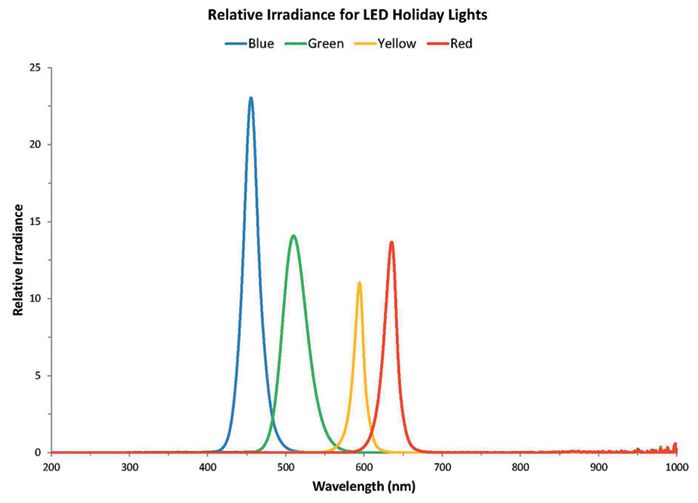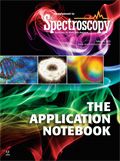Relative Irradiance of Decorative Incandescent and LED Lights
Application Notebook
Although most often associated with Christmas, multicolored holiday lights are used year-round as an appealing decorative accent.
Although most often associated with Christmas, multicolored holiday lights are used year-round as an appealing decorative accent. Today, LED lights are as ubiquitous as incandescent lights, with manufacturers touting their low power requirements, high efficiency, and bright color. But how do LEDs compare with incandescent decorative lights? Here's what we discovered when measuring the relative irradiance of several multicolored light strings.
Experiment Materials and Spectrometer Setup
We tested one string of 20 multicolored incandescent lights and two strings of multicolored LED lights - one was a new, 10-light string and the other was a slightly used, 20-light string. The incandescent lights were purchased at a local pharmacy for about $4 and the newer LEDs for $5 (for half as many lights). All the lights were manufactured in China.

Our measurement setup comprised a spectrometer (200–1025 nm), an integrating sphere, an optical fiber, and spectroscopy software. We used a radiometrically calibrated light source as the reference and measured the incandescent lights and newer LED lights straight from their packaging and the older LEDs on a "tree" fashioned out of laboratory clamps and fittings.
Measurement Results
The incandescent lights that we measured had broadband spectra with very strong intensity in the shortwave NIR region >700 nm (Figure 1). The light at these wavelengths produces heat, which makes the bulb warm during operation.

Figure 1: In incandescent lights, heat results from the spectral output at wavelengths >700 nm.
The LED light strings that we measured had narrowband emission with no intensity in the shortwave NIR region >700 nm, which allows the bulbs to remain cool to the touch even after long periods of operation. In addition to producing less heat, the LEDs are more energy efficient than incandescent lights.
Generally, the LEDs produced brighter colors than the incandescent lights, especially in the blue and green bulbs (Figure 2).

Figure 2: The LED bulbs had strong output for the colors tested, especially at blue and green wavelengths.
What Can Relative Irradiance Measurements Reveal?
The spectrometer setup used for these measurements showed good results for the incandescent and LED lights tested, providing some insight into the differences between the two types. Variability in performance between the LED strings also was observed. Our experiment suggested that the LEDs perform very well spectrally, although to make an assessment of cost effectiveness versus incandescent lights would require additional testing and analysis.
Ocean Optics
830 Douglas Avenue, Dunedin, FL 34698
tel. +1 (727) 733-2447, fax +1 (727) 733-3962
Website: www.OceanOptics.com

Newsletter
Get essential updates on the latest spectroscopy technologies, regulatory standards, and best practices—subscribe today to Spectroscopy.
Scientists Use Water and Light to Uncover Honey Adulteration
July 30th 2025In a 2025 study, Indian researchers demonstrated that combining near-infrared (NIR) spectroscopy with aquaphotomics enables rapid, non-destructive detection of adulterants in honey by analyzing changes in water’s spectral behavior. Using chemometric models, they accurately identified and quantified six common adulterants, offering a powerful tool for food authenticity and quality control.
Scientists Use AI and Spectroscopy to Detect Fake Honey in Bangladesh
July 29th 2025Researchers in Bangladesh have developed a rapid, non-destructive method to detect honey adulteration using UV-Vis-NIR spectroscopy paired with machine learning. Their findings could protect consumers and support food quality enforcement.